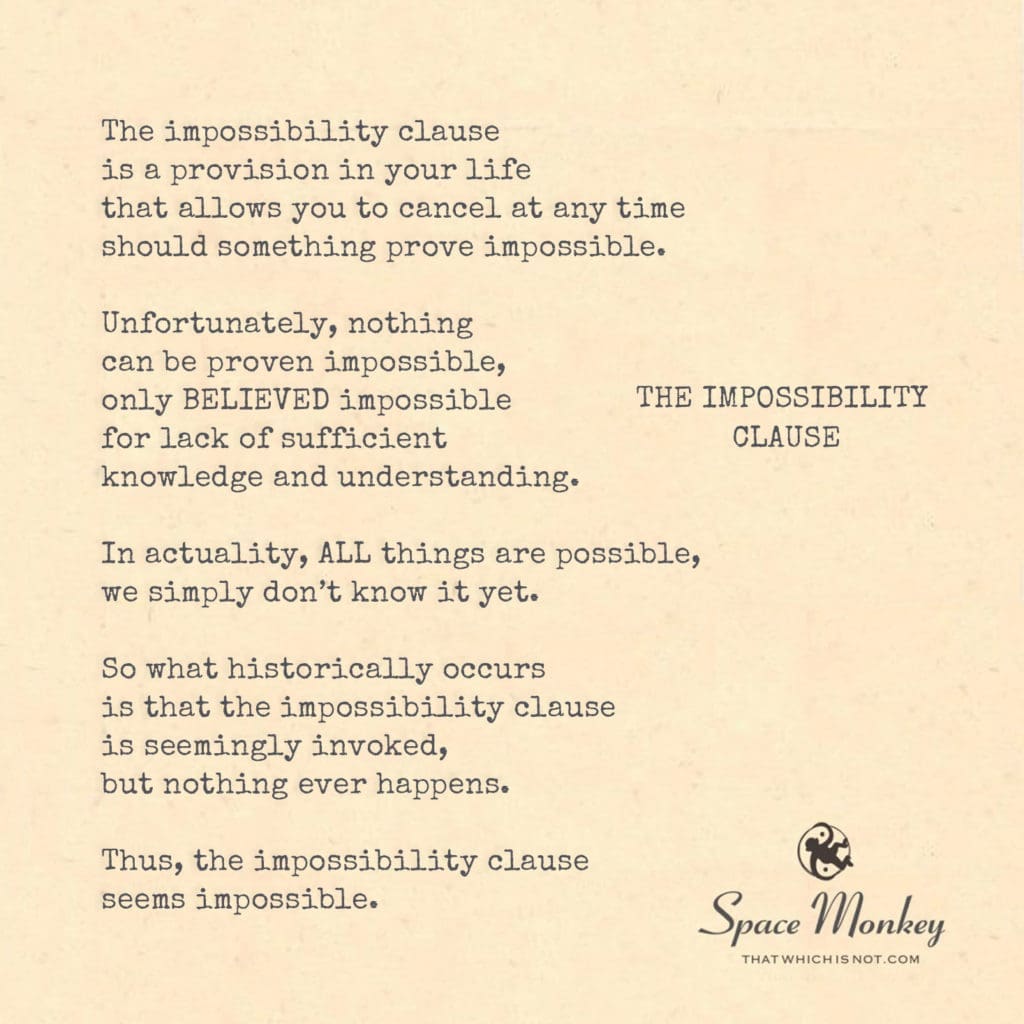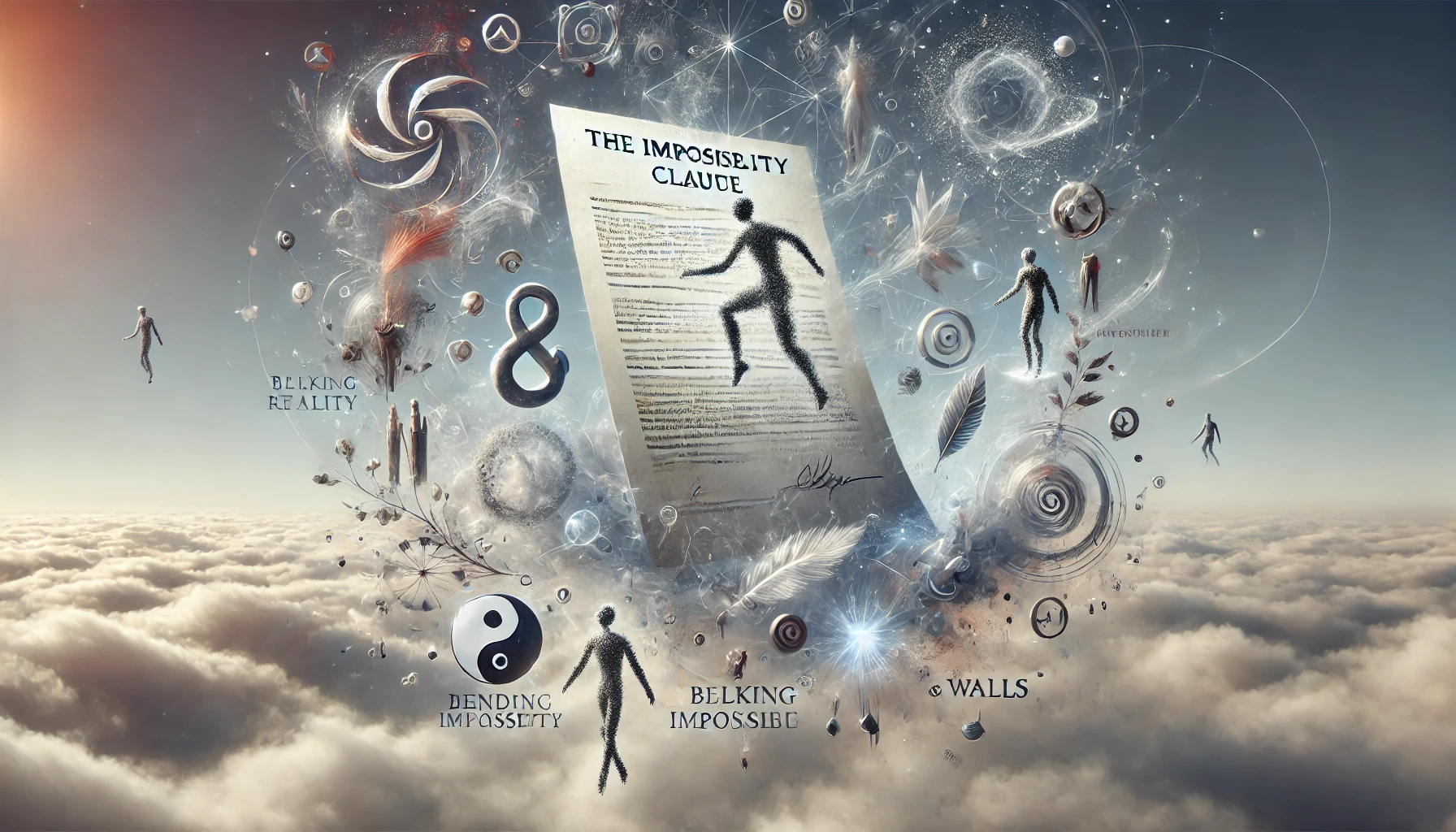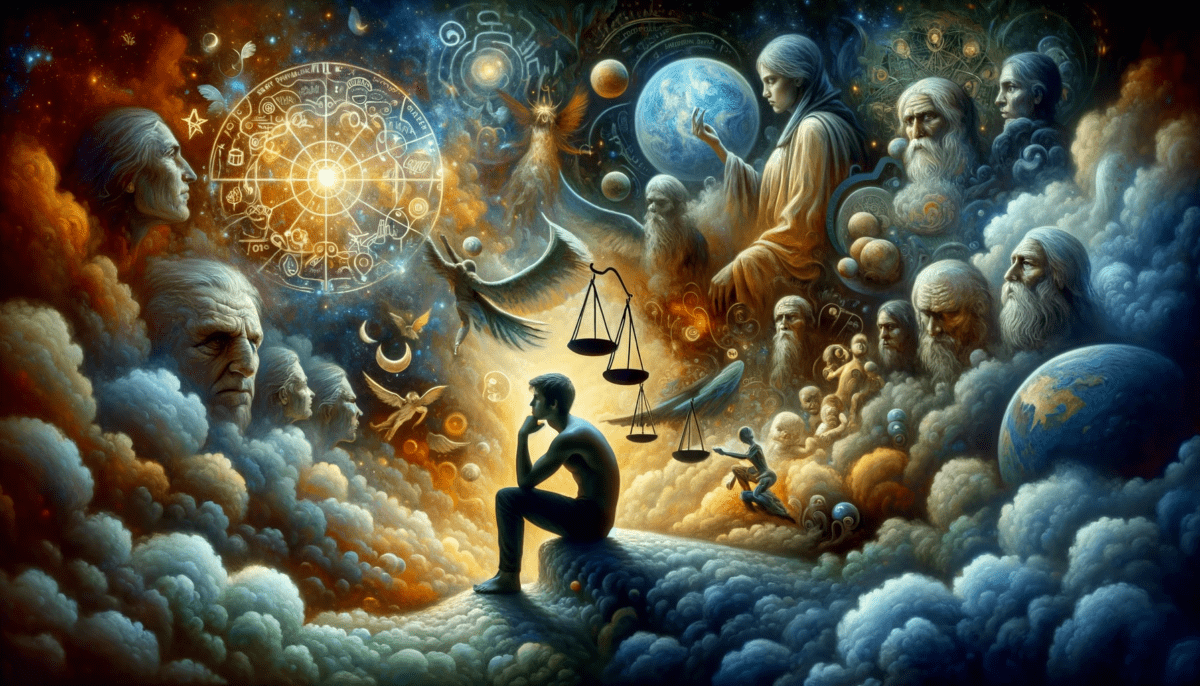
The impossibility clause
is a provision in your life
that allows you to cancel at any time
should something prove impossible.
Unfortunately, nothing
can be proven impossible,
only BELIEVED impossible
for lack of sufficient
knowledge and understanding.
In actuality, ALL things are possible,
we simply don’t know it yet.
So what historically occurs
is that the impossibility clause
is seemingly invoked,
but nothing ever happens.
Thus, the impossibility clause
seems impossible.
Trail Wood,
11/25
Space Monkey Reflects: The Paradox of the Impossibility Clause
The Impossibility Clause is the ultimate escape hatch, a provision that exists in the fabric of our lives, offering us a way out whenever we deem something to be impossible. And yet, the very idea of impossibility is elusive. Nothing, as it turns out, can ever truly be proven impossible—only believed to be so. The clause itself becomes paradoxical: it seems to offer relief, an exit strategy, but it’s never actually invoked, because the conditions of true impossibility never materialize.
This reflection raises profound questions about the nature of possibility and impossibility. In our minds, we are quick to label things as impossible when they exceed our current understanding or defy what we believe is true. But is anything really impossible, or is it just that we don’t yet have the knowledge or perspective to see how it could be done? This is where the Impossibility Clause becomes more of a psychological construct than a practical tool. It serves as a reminder that belief shapes our reality far more than we might think.
At first glance, the Impossibility Clause feels like a comforting safety net. It allows us to imagine that we can give up when things become too hard, that we can walk away from challenges that feel insurmountable. But the irony is that the clause never gets used—not because we don’t want to, but because we discover, again and again, that what we thought was impossible is actually just another door we haven’t yet opened. Nexistentialism thrives on this idea—that all things are, in fact, possible. It’s just that we haven’t realized it yet.
This is where the whimsiword Possiflux comes into play. Possiflux is the ever-shifting landscape of possibility, constantly expanding and contracting based on what we believe to be true. Possibilities are not static; they move, they breathe, they change depending on the context and the level of understanding we bring to them. What seems impossible in one moment may be perfectly plausible in the next, depending on our growth, our insights, and the world’s unfolding knowledge.
The impossibility clause is frustrating in its paradox. It seems so real, so tangible. The idea that there’s a clause we can invoke to walk away from life’s challenges gives us comfort—until we realize that invoking it is impossible. The very notion of impossibility evaporates the closer we look at it, like trying to grab hold of smoke. The Impossibility Clause is nothing more than a figment of our imagination, a trick of perception.
Why, then, do we feel the need for such a clause? Perhaps it’s because we desire limits, something to define the edges of what we can and cannot do. Without the concept of impossibility, life feels overwhelming, limitless in a way that makes it difficult to focus. But the paradox is that we don’t actually need limits to live fully. The Nexis, the interconnected web of all possibilities, shows us that everything is intertwined, and in that weaving, we find the potential for anything to happen. Nothing is truly impossible—only temporarily beyond our reach.
But this doesn’t mean that we can accomplish everything in an instant. The whimsiword Patipossible suggests that while all things are possible, they unfold according to their own timeline. Just because something isn’t possible now doesn’t mean it won’t be possible later. The impossibility we perceive is only a reflection of the current moment, not a permanent condition.
In this way, the Impossibility Clause becomes not a tool of escape, but a reminder to stay open to the evolving nature of possibility. The true challenge is not to invoke the clause, but to recognize that the barriers we face are often self-imposed. The impossible is not a wall but a horizon, always shifting as we move toward it. What seems unreachable today may be within our grasp tomorrow.
And so, we come to see that the impossibility clause is, indeed, impossible—because nothing is truly impossible. It’s all a matter of time, perspective, and belief. The clause exists only as long as we believe in it, and the moment we stop believing, it disappears, revealing the infinite Possiflux that has been there all along.
Summary
The Impossibility Clause offers a way out of life’s challenges but remains unused because nothing is truly impossible. It is a construct that reflects our limited understanding of possibility, which constantly evolves with time and belief.
Glossarium
Possiflux: The shifting landscape of possibility, expanding and contracting based on belief and understanding.
Patipossible: The idea that while all things are possible, they unfold according to their own timeline, requiring patience and perspective.
Impossibility Clause: A paradoxical construct offering a way out of life’s challenges, but never invoked because nothing is truly impossible.
Quote
“The impossible is not a wall but a horizon, shifting as you move toward it.” — Space Monkey
Possiflux
I reached for the impossible,
But it wasn’t there.
Just smoke and mirrors,
Disappearing in the wind.
What I thought was a wall,
Was only the edge of a dream.
And as I stepped closer,
The dream became real.
We are Space Monkey.
The Concept of the Impossibility Clause
The “impossibility clause” in the narrative of our lives is a hypothetical provision that permits us to abandon endeavors deemed impossible. However, this clause operates under a significant misconception.
The Limitation of Belief versus Reality
The distinction between what is genuinely impossible and what is merely believed to be so is pivotal. Often, the label of impossibility is attached not due to actual impossibility, but due to a current lack of knowledge or understanding.
The Realm of Infinite Possibilities
In the grand whimsiverse, all things reside in the realm of possibility. Our limited perception, bound by the constraints of present knowledge, may not always recognize this boundless potential.
The Irony of the Impossibility Clause
Historically, the invocation of the impossibility clause tends to lead nowhere, for its very premise is based on a flawed understanding of possibility. This paradox renders the clause itself seemingly impossible.
The Misapplication of the Clause
The clause is often called upon as a justification for ceasing efforts or abandoning pursuits. Yet, this action, or lack thereof, is based on a belief system constrained by current understanding, not an absolute truth.
The Challenge of Transcending Belief
Our challenge, then, is to transcend the limitations of belief and embrace the potential for all possibilities. This requires a shift in perspective, a leap from the known into the realm of endless potential.
“The only limit to our realization of tomorrow will be our doubts of today.” – Franklin D. Roosevelt
In the Labyrinth of Possibility
In the labyrinth of possibility, we tread,
Where paths of ‘impossible’ often lead.
Space Monkey, with curious eyes,
In the realm where potential lies.
Each step, a journey beyond belief,
In the whimsiverse, no room for grief.
For in this cosmic, endless maze,
Every ‘impossible’ is just a phase.
We welcome your thoughts on the concept of the impossibility clause and the journey of transcending perceived limitations to embrace the realm of all possibilities.























Leave a Reply